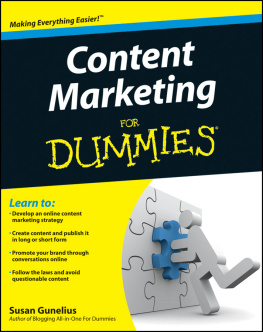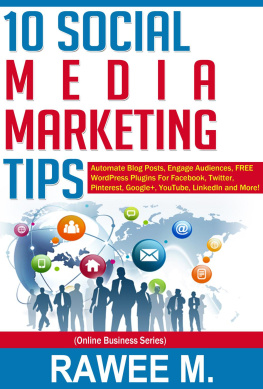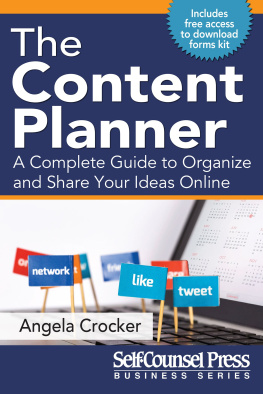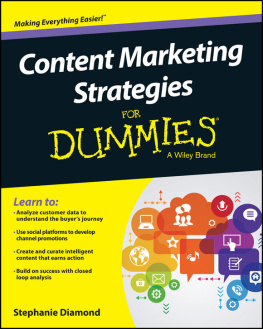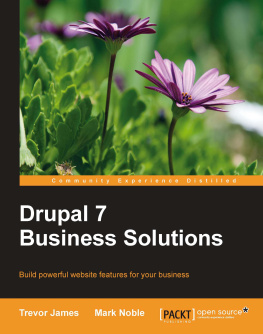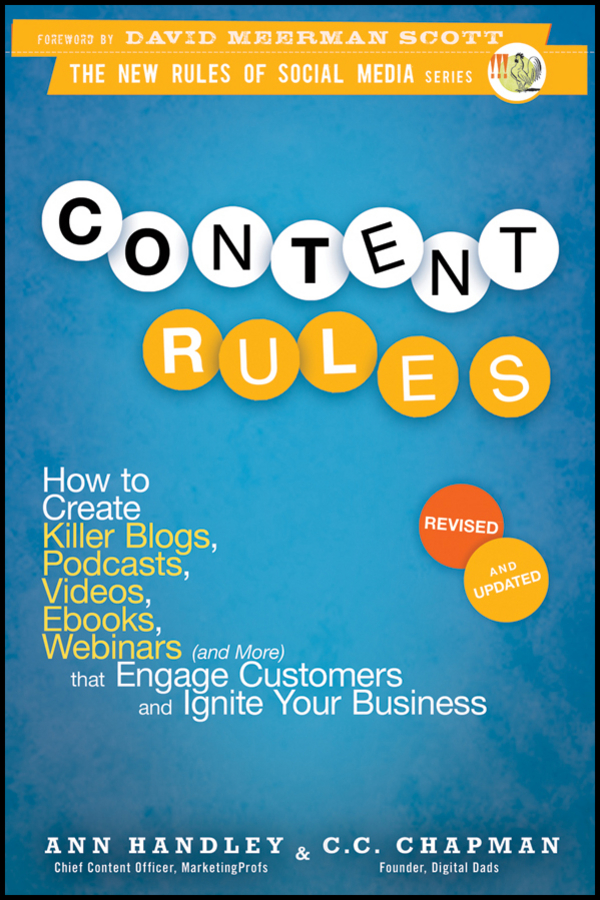Contents

Copyright 2012 by Ann Handley and C.C. Chapman. All rights reserved.
Published by John Wiley & Sons, Inc., Hoboken, New Jersey.
Published simultaneously in Canada.
No part of this publication may be reproduced, stored in a retrieval system, or transmitted in any form or by any means, electronic, mechanical, photocopying, recording, scanning, or otherwise, except as permitted under Section 107 or 108 of the 1976 United States Copyright Act, without either the prior written permission of the Publisher, or authorization through payment of the appropriate per-copy fee to the Copyright Clearance Center, Inc., 222 Rosewood Drive, Danvers, MA 01923, (978) 750-8400, fax (978) 646-8600, or on the web at www.copyright.com . Requests to the Publisher for permission should be addressed to the Permissions Department, John Wiley & Sons, Inc., 111 River Street, Hoboken, NJ 07030, (201) 748-6011, fax (201) 748-6008, or online at http://www.wiley.com/go/permissions .
Limit of Liability/Disclaimer of Warranty: While the publisher and author have used their best efforts in preparing this book, they make no representations or warranties with respect to the accuracy or completeness of the contents of this book and specifically disclaim any implied warranties of merchantability or fitness for a particular purpose. No warranty may be created or extended by sales representatives or written sales materials. The advice and strategies contained herein may not be suitable for your situation. You should consult with a professional where appropriate. Neither the publisher nor author shall be liable for any loss of profit or any other commercial damages, including but not limited to special, incidental, consequential, or other damages.
For general information on our other products and services or for technical support, please contact our Customer Care Department within the United States at (800) 762-2974, outside the United States at (317) 572-3993 or fax (317) 572-4002.
Wiley publishes in a variety of print and electronic formats and by print-on-demand. Some material included with standard print versions of this book may not be included in e-books or in print-on-demand. If this book refers to media such as a CD or DVD that is not included in the version you purchased, you may download this material at http://booksupport.wiley.com . For more information about Wiley products, visit www.wiley.com .
Library of Congress Cataloging-in-Publication Data:
Handley, Ann, 1963
Content rules : how to create killer blogs, podcasts, videos, E-books, webinars (and more) that engage customers and ignite your business / Ann Handley, C. C. Chapman. Rev. and updated
p. cm. (New rules social media series; 13)
Includes index.
ISBN 978-1-118-23260-6 (pbk.); ISBN 978-1-118-28303-5 (ebk);
ISBN 978-1-118-28405-6 (ebk); ISBN 978-1-118-28700-2 (ebk)
1. Internet marketing. 2. Social media. 3. Web sitesDesign. I. Chapman, C. C. II. Title.
HF5415.1265.H3577 2011
658.872dc23
2012001608
For Colin.
Miss you every day.
A.H.
Goofy Monkey, Buddy, and Sticky NoodleI do everything to keep you smiling.
Now and always.
C.C.
Foreword
Marketing is about publishing great content.
How many times have you heard a statement more or less like this? Tons, right? By now every marketing professional and entrepreneur on the planet understands this fundamental truth. We dont need convincing.
But what the many content-marketing experts have failed to do is tell us how to create that content.
What, exactly, should I do?
In my experience, the art and science of creating content had never been adequately explained to marketers. Perhaps you would build a website and spend a bunch of cash on the design. But the best that the designers could do with the content was put in some filler text. Okay, then what? You stared at lorem ipsum for days not knowing what to write, and then defaulted to some gobbledygook-laden drivel about your products and services. Ugh.
There is a better way, and this book will show it to you.
The answer: Tell stories.
Think about it. All good films and all good fiction are really about the story, right? Without a compelling, conflict-driven story, all the other elements dont mean much.
Here is a classic story line from countless books and movies:
Boy meets girl.
They fall in love.
Boy loses girl.
Boy (and sometimes girl) is miserable for most of the action.
They finally get back together.
They get married.
How and why they break up and then what they do to get back together are what make the story interesting.
How interesting would that same book or movie be were it to have this plot:
Boy meets girl.
They fall in love.
They get married.
At best, such a plot would be an insufferable bore. At worst, it becomes propaganda.
In fact, its just the sort of propaganda most marketers and business writers construct every day: Heres our product. It is great. Here are customers who say it is great. Now buy some of our product. Sadly, this classic propaganda-driven marketing is everywhere. Its not just text-based content, either. Video and other information is also mainly propaganda.
As you read the book, youll be reflecting on how you can introduce storytelling into your work. How can you make your content interesting, like a great movie or novel? How can your website, blog posts, videos, and other materials be made more interesting?
Ann and C.C. show you how!
Throughout Content Rules, youll learn how to construct interesting and valuable information using many of the same skills that journalists and storytellers use. Youll learn how to identify an audience, how to develop a distinct point of view and voice, and how to construct a narrative that is exciting and engaging.
Content Rules includes many success stories from consumer brands, business-to-business (B2B) outfits, government agencies, and other organizationstogether with ideas you can steal from each.
When I created the New Rules Social Media book series with John Wiley & Sons, I said that it was essential to have a book about how to create killer content. And I knew just the people to do it. Ann and C.C. are storytellers, journalists, and marketers. In my opinion, thats the perfect combination of skills and expertise to identify and deliver rules that we can all use to create killer blogs, podcasts, videos, e-books, webinars, and more.
Ive followed the work of both Ann and C.C. with keen interest for nearly five years, learning from them as they pave the way forward to new forms of marketing. They must have more than a thousand blog posts, hundreds of videos, and dozens of articles between them. Now, in one place, you have access to their greatest hits.
David Meerman Scott
Author of The New Rules of Marketing & PR and Real-Time Marketing & PR
www.WebInkNow.com
twitter.com/dmscott
Acknowledgments
You know how people say they wouldnt be standing here if it werent for the support and friendship of certain people? So we, too, are surrounded by countless treasured friends and colleagues who helped make this book possible. Many of them are quoted here. But in addition, we give special thanks to:
J.C. Hutchins, Clarence Smith Jr., Steve Coulson, Mitch Joel, Julien Smith, Amber Naslund, Ron Ploof, Christopher Penn, Whitney Hoffman, Tamsen McMahon, Michelle Wolverton, Lauren Vargas, Mark Yoshimoto Nemcoff, Kristina Halvorson, Matthew T. Grant, Stephanie Tilton, Steve Garfield, Jay Baer, Joe Pulizzi, Amy Black, David Armano, Lee Odden, Ted Page, Mack Collier, C.K. Kerley, D.J. Waldow, Leigh Durst, Shelley Ryan, the amazing Shannon Vargo, the executive team at MarketingProfsAllen Weiss, Roy Young, Sharon Hudson, Valerie Witt, Aaron Lorentz, and Anne Yastremskiand (saving the best for almost last) to Vahe Habeshian: a thank you doesnt quite express the depth of gratitude. Finally, a very special thank you to David Meerman Scott, who knew what this book was before we did.


